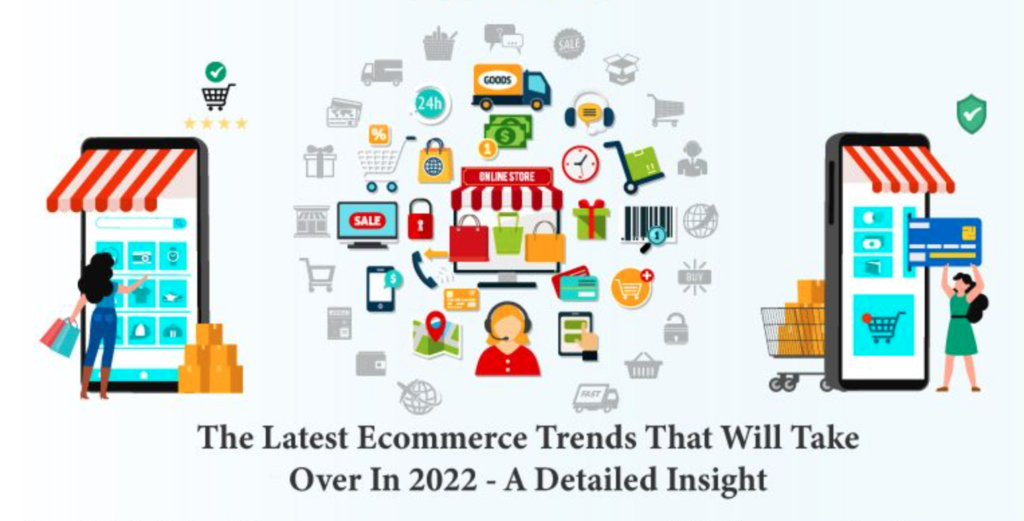
Table of Contents:
- Emerging Trends in e-Commerce
- 10 e-Commerce Trends to Expect in 2022
- What are the B2B e-Commerce Trends?
- Conclusion
- Key Takeaways
- FAQs

e-Commerce has snowballed in the past few years. It is expected to grow even faster in the coming years, and it’s one of the most exciting industries to be in right now.
This list of 10 e-Commerce trends to expect in 2022 will give you an idea of where this industry might be headed over the next few years and what kind of growth we can expect to see overall as e-Commerce continues to dominate retail sales around the world.
Some of these trends may surprise you, but we believe they’re all well worth paying attention to.
Emerging Trends in e-Commerce
Recent e-Commerce trends have centered around omnichannel delivery and customer experience. Recent statistics have highlighted the strong growth of online purchases across both industries, but with different growth rates. You need to look for an increasing number of online transactions to affect all industries.

If you want to keep up with e-Commerce trends in your industry, it’s important to know where your customers are shopping online now and what they’re looking for in the future. This will help you identify opportunities to develop strategies that improve your e-Commerce sales figures.
10 e-Commerce Trends to Expect in 2022
If you’re looking to stay ahead of competitors, there are some trends business owners should be preparing for in 2022. While some are hard to predict, there are a few that you can get ahead of by preparing today.
Online shopping trends are constantly changing, so staying up-to-date on what’s new will help you keep pace with your competitors.
And if you don’t have competition yet? Create some. It may seem counterintuitive, but sometimes beating someone else to market can give you an edge over companies who wait too long to get started.
Emerging trends in e-Commerce will have a huge impact on how companies and consumers transact business. While some of these trends will take time to become mainstream, others are already taking hold. Here are ten e-Commerce trends you should prepare for in 2022:
1. Rise of mobile
Mobile commerce is a growing area and one that every e-Commerce site will have to tackle. As more users go mobile, e-Commerce companies need to ensure their sites are optimized for mobile use.

A good first step is to keep your mobile site clean and free of ads—users might be on their phones, but they still want an enjoyable experience when shopping online. In addition, you’ll also want to take advantage of location-based services so you can provide information about nearby stores or other locations relevant to your business.
The key is to make it easy for customers to find what they’re looking for without overwhelming them with too much information.
Keep things simple, and remember: no matter how much time you spend optimizing your site for mobile, there’s always room for improvement. The best way to prepare for trends like these is to stay up-to-date on changes in technology and consumer behavior—and then act accordingly.
Another important trend is ensuring you’re making it easy for customers to pay with their phones. At the same time, many consumers may not yet have adopted Apple Pay or Google Wallet, those who love being able to pay quickly without fumbling with cash or credit cards.
2. Increase in digital payments
According to a Live Mint report, digital payments in India grew over 90% from 2017 to 2021. This growth is projected to continue as business owners recognize how useful e-Commerce can be for selling products online.
While B2C (business to consumer) transactions are growing faster, B2B (business to business) transactions will also see exponential growth, with over $200 billion being transacted in just two years. In 2022 it’s predicted that digital payments will account for half of all purchases.
Due to such high growth rates, business owners must recognize how useful e-Commerce can be for selling products online. What was once a niche market quickly became mainstream as more consumers are expected to shop online than in brick and mortar stores by 2022.
3. Flexible shipping options
According to Live Mint, 59% of shoppers indicated that flexible shipping options would impact their purchasing decisions. But as we enter into a more digital world, consumers demand and expect to be able to decide how they want their orders delivered.
While customers could get around having bulky packages shipped by pick-up or drop-off locations, e-Commerce platforms are adapting too. Today’s e-Commerce trends prioritize convenience and user experience above all else.

Platforms like Amazon have already begun offering same-day delivery for Prime members; others like Jio Mart have experimented with pop-up stores where customers can order online and then pick up their package at a local store.
Flexible shipping is one of many e-Commerce trends to watch out for in 2022 and beyond. As online shopping trends continue to evolve, certain things will remain constant (like free shipping), other aspects will change dramatically over time.
4. Consumers prioritize the customer experience over products
Customer experience is critical for future e-Commerce success. Shoppers are always looking for a reason to purchase from your competitor instead of you. If they don’t feel confident in their purchases or service, they will look elsewhere to spend their money.
Companies that focus on creating and maintaining great customer experiences will be rewarded with loyal shoppers, repeat business, and word-of-mouth referrals.
According to Forbes, 75% of customers say they would pay more for better customer service. It makes sense to invest in an online platform that supports seamless shopping experiences and provides excellent support throughout all transaction stages.
5. Big data analytics and personalization
Big data analytics tools and algorithms will continue to improve, making it easier to make intelligent personalization decisions.
With proper analysis, businesses will be able to collect more data on their customers than ever before. These businesses can also make extremely accurate inferences about what kinds of products people want and how they might want them presented.

This means that e-Commerce companies will be able to offer better recommendations based on what they know about a customer’s preferences and interests.
This trend helps e-Commerce companies maintain their competitive edge over brick-and-mortar stores, which don’t have access to as much information about their customers.
6. Omnichannel integration
Everyone talks about omnichannel these days, but few retailers have figured out how to make it work. If you’re not integrating your social media with your website and other channels (i.e., mobile apps), you’re missing out on a huge opportunity for customer engagement and brand awareness.

The most popular emerging trend in e-Commerce is conversational commerce—where shoppers can interact with brands through messaging apps like Facebook Messenger or WhatsApp. Don’t forget that your email marketing strategy needs to tie into all of these channels.
Omnichannel integration is also important because customers are increasingly shopping across multiple devices, and they expect to be able to access information and purchase products from any of those devices.
7. Human emotions tracking
As AI becomes more integrated into our daily lives, researchers will begin to develop new ways of tracking emotional data. When you watch a video on YouTube or listen to a song on Spotify, you’re adding more data to computers learning your preferences.
That data informs algorithms that can understand you better than ever before – and as we start trusting AI with more of our everyday tasks, these emotional interactions will be used by companies in ways we haven’t even begun to imagine.
While businesses have always looked for ways to connect with their customers, understanding human emotions through technology will create new e-Commerce opportunities.
How often have you purchased something online because it made you feel happy? Or bought an item because it reminded you of a special moment? e-Commerce trends in 2022 will take advantage of these connections between people and machines.
8. Live shopping
The live stream is one of those buzzwords that you hear about everywhere. But it’s not just for social media or news organizations anymore. e-Commerce sites are also getting on board with real-time shopping. And shoppers love it—84% of consumers prefer live video to prerecorded content, according to LivePerson and The Video Advertising Bureau.

Livestream can be used to introduce new products, engage customers with special offers, and provide support for existing customers. 40% more shoppers buy something after watching a live video demo than when using prerecorded videos. So, if you haven’t already got on board with live streaming, now might be a good time to start.
9. Influencer marketing
With over three billion Internet users worldwide and customer expectations at an all-time high, e-Commerce businesses are looking for innovative ways to gain an edge over their competition.
If you’re looking to grow your e-Commerce brand beyond its current size, there’s no better way than influencer marketing.
By leveraging powerful social media personalities and celebrity endorsements, you can launch a new product or drive more traffic to your site—and ultimately help increase sales.
10. Voice Search
The rise of voice search can be directly attributed to a dramatic increase in smart home technology. Voice commerce has more than doubled in just two years and is expected to continue growing. Voice commerce is a beneficial e-Commerce trend in 10 key ways:
- Change shopping behaviors
- Change how people shop
- Affect e-Commerce growth rates
- Impact mobile commerce
- Affect customer expectations
- Change how brands engage with customers
- Impact social media marketing strategies
- Impact e-Commerce marketplaces
- Change customer relationships
- Change e-Commerce marketing strategies
Many other e-Commerce statistics show how consumers are already making purchases through their voices—and it’s only going to get bigger from here.
In 2022, Gartner predicts that 25% of all searches will be done by voice. This means your ads need to be able to target specific users based on where they are in their purchase journey. It also means you should have a clear call to action, so customers know what they need to do next.
Insert general services banner here
What are the B2B e-Commerce Trends?
e-Commerce statistics show that buyers are moving away from physical stores and toward digital shopping, while demand for B2B e-Commerce products is growing at a steady rate. You need to know about B2B e-Commerce trends: from intelligent chatbots to augmented reality (AR) technology.
1. Spread of voice search

Voice search is expected to become a $40 billion industry in the near future, which means it will be an increasingly important part of e-Commerce trends.
Google Home, Amazon Echo, and other voice assistants are quickly becoming ubiquitous parts of people’s homes, which means there will be more opportunities for brands to reach their customers through smart speakers and other devices.
2. Rise of micro-moments
Consumers are increasingly relying on mobile devices to inform their purchasing decisions. This means brands need to be able to provide information quickly and easily when consumers are most likely to act.
This is why e-Commerce trends will continue to focus on providing customers with relevant information at just the right time.
3. Rise of instant payments
Consumers are also increasingly relying on mobile devices to complete their purchases, which means e-Commerce trends will continue to focus on providing customers with quick and easy ways to pay for products and services.
4. Intelligent chatbots
Chatbots aren’t new, but they’re becoming more popular as e-Commerce trends shift toward voice search and instant payments—and that means brands need to be prepared for more opportunities to interact with consumers through intelligent chatbots.
5. Augmented reality (AR) technology
AR technology isn’t new, but it’s becoming more popular as consumers rely on mobile devices to inform their purchasing decisions.
Brands that can integrate AR technology into their e-Commerce strategies will be able to offer customers unique and interesting features that other brands aren’t showing.
6. Development of new delivery methods
e-Commerce trends focus on providing customers with fast and easy ways to get their products, which means companies will continue to find new and better ways to deliver their products.
7. Lightning-fast fulfillment through automated order management
e-Commerce trends are moving toward instant payments and fast delivery, which means brands need to be able to provide consumers with lightning-fast shipping options.
8. Real-time inventory management
Consumers want their products quickly, which means e-Commerce trends will continue to focus on providing real-time inventory information that lets customers know exactly when their orders will arrive.
9. API-driven B2B e-Commerce
APIs are becoming increasingly popular as e-Commerce trends shift toward real-time inventory management and lightning-fast shipping. This means brands need to be prepared for more opportunities to integrate their e-Commerce strategies with third-party platforms.
10. B2B online marketplaces
B2B e-Commerce trends are moving toward online marketplaces, which means companies will have more opportunities to expand their reach and provide customers with new products and services.
Conclusion
The e-Commerce industry has been booming over recent years, and consumer preferences are evolving.
Online shopping trends will keep evolving at an accelerated pace over the next few years, so keep up with what’s happening. If you want to stay ahead of your competition and capture your share of online sales, make sure you have a strategy today.
Online stores that want to survive for longer will need to adapt their strategies to meet customer demand—which is where it gets tricky.
Some of these trends are relatively new, and many have been around for some time now. But they will most certainly continue to evolve, becoming even more crucial to a successful e-Commerce operation.
As you can see, there is no one size fits all answer that applies to every business model. Instead, you need to strategically tailor your e-Commerce operations plan based on your business objectives and goals.
Key Takeaways
- e-Commerce will continue to grow rapidly as more businesses transition to digital channels and start selling online.
- Businesses will have to adapt their business models and strategies to fit an increasingly digital world.
- It is important to note that these trends are not set in stone, and there is always a chance that some of them may not come to fruition as expected or could be modified before they have an opportunity to affect businesses around the world.
FAQs
Consumers are embracing online shopping more than ever before, B2B businesses taking advantage of it by buying and selling goods on a global scale.
Consumers are becoming more and more comfortable with purchasing online. As a result, e-Commerce sales will continue to grow, and as consumers become more familiar with buying online, they’ll expect to be able to pay for their purchases through their preferred payment method.
With a steadily growing number of tech giants like Google, Apple, and Amazon pushing to make mobile payments mainstream as soon as possible, e-Commerce will change dramatically over the next few years.
Latest Blogs
Learn how to rank on AI search engines like ChatGPT, Perplexity, and Gemini by optimizing your content for authority, structure, and relevance. Stay ahead in AI-driven search with this strategic guide.
Explore the best healthcare SEO services for your medical practice. Improve online visibility and effectively reach more patients in need of your services.
Discover top social media agencies specializing in banking solutions, enhancing financial services and driving engagement.
Get your hands on the latest news!
Similar Posts

Content
5 mins read
How to Write Killer E-commerce Content

Branding
6 mins read
12 Ways to Promote Your Brand on Etsy

Branding
8 mins read